Original Author: Siddhant Kejriwal
Translated by: Block unicorn
With the arrival of 2024, the cryptocurrency field is experiencing a groundbreaking resurgence, bringing substantial returns to those who have withstood the latest bear market storm. This revival is not just a rebound in value; it demonstrates the resilience and evolving nature of the cryptocurrency ecosystem. Resolute investors, enthusiasts, and innovators are now at the forefront of revitalizing space, witnessing the birth of groundbreaking ideas and the unfolding potential of cryptocurrencies, turning them into substantial, innovative applications far beyond mere speculative assets.
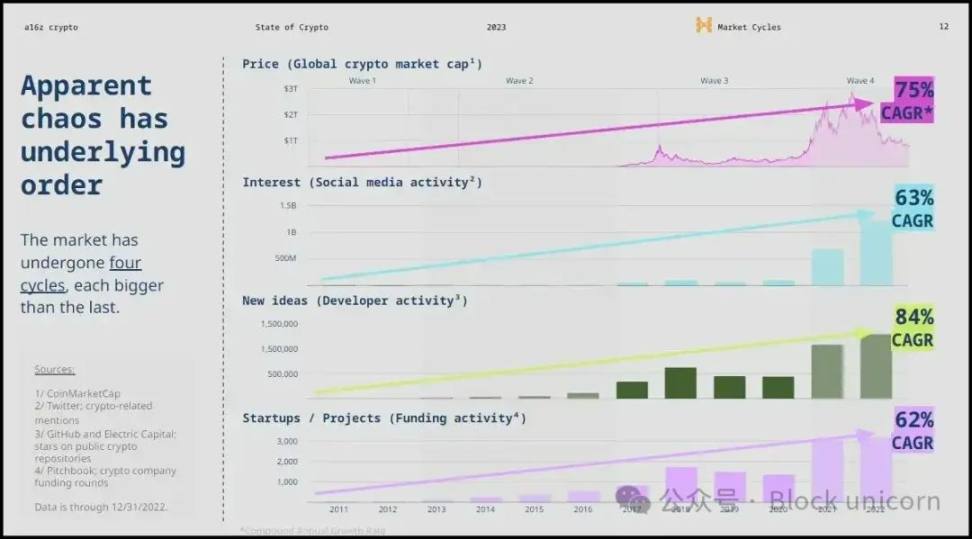
a16z's "2023 Cryptocurrency Report"
A striking infographic in a16z's "2023 Cryptocurrency Report" supports this vibrant resurgence, showcasing the global robust interest in cryptocurrencies. Not only is the price rising; the influx of new ideas, the increase in startups, and the expansion of user base have led to a compound annual growth rate (CAGR) ranging from 63% to 84% since 2012. This strong growth narrative highlights the dynamic evolution of the cryptocurrency industry, underscores its resilience, pushes the boundaries of possibility, and opens a new era of innovation and opportunities.
This article delves into some of the most notable new stories shaping the cryptocurrency field in 2024. From the transformative potential of decentralized finance (DeFi) to pioneering advancements in tokenizing real-world assets, the breadth of innovation is staggering. However, it is crucial to approach these cutting-edge areas with caution. Many of these concepts, while promising, are still in their infancy, with their actual applications yet to be fully realized and tested. Additionally, the ever-changing regulatory environment brings additional complexity and potential resistance.
As we begin to explore the top cryptocurrency narratives, it is essential to remain vigilant, recognize the infinite possibilities, and be mindful of the uncertainties and challenges ahead.
Liquidity Staking Tokens: Reshaping Staking Dynamics
In traditional staking models, participants lock assets to support network operations, facing liquidity constraints as a trade-off for earning rewards. Liquidity staking emerges as an innovative game-changer, addressing this fundamental issue by allowing stakers to maintain liquidity while staking assets. The demand for this approach is growing as it harmonizes the benefits of staking with the flexibility of liquid assets, enabling participants to maximize operational efficiency and financial opportunities within the blockchain ecosystem.
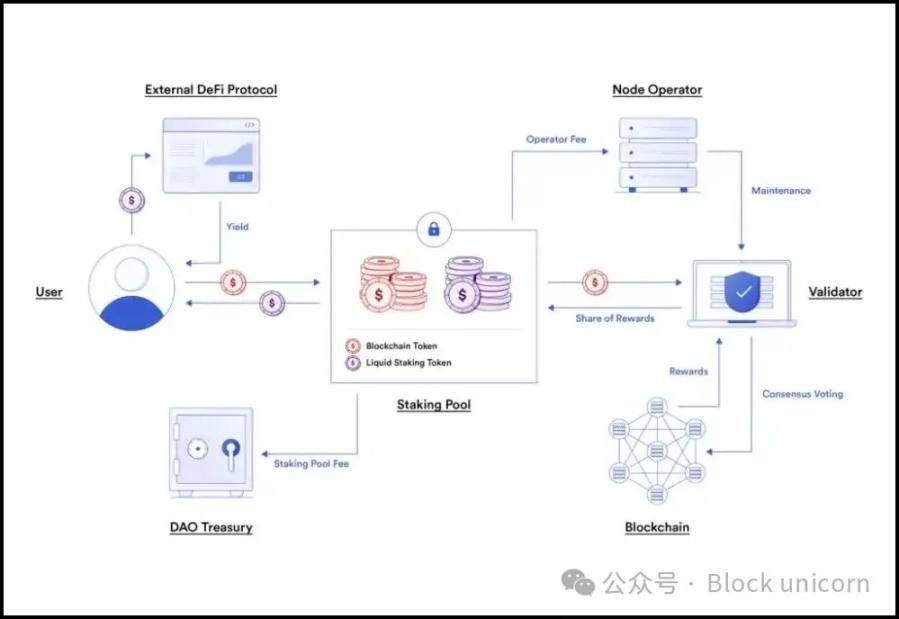
Chainlink illustrates the liquidity staking mechanism
Benefits and Risks of Liquidity Staking
Liquidity staking brings several benefits to enhance the staking experience:
- Enhanced liquidity: Stakers receive liquidity tokens representing their staked assets, allowing them to use them in various DeFi applications without forgoing staking rewards.
- Increased participation: Liquidity staking encourages broader participation in network security by lowering entry barriers and enhancing decentralization.
- Flexibility and efficiency: Participants can quickly respond to market changes, utilizing their liquidity tokens for trading, lending, optimizing asset utility.
However, these advantages come with associated risks:
- Smart contract vulnerabilities: Relying on smart contracts introduces a layer of risk, where flaws or vulnerabilities could lead to fund losses.
- Market volatility: The value of liquidity tokens may fluctuate, introducing market risk components not typically present in traditional staking.
- Complexity and interdependence: Integrating various DeFi protocols increases complexity and interdependence, potentially exacerbating systemic risks within the blockchain ecosystem.
Notable Liquidity Staking Projects:
Several prominent projects are at the forefront of the liquidity staking movement, significantly impacting the Web3 landscape:
- Lido: As a leader in liquidity staking, Lido provides a solution across multiple blockchains, facilitating staking without locking assets, thereby enhancing liquidity and participation.
- Rocket Pool: Rocket Pool offers decentralized, trustless staking services for Ethereum, promoting accessibility and network health.
These projects and others are leading the transformation towards a more liquid, dynamic, and inclusive staking environment, nurturing a robust Web3 ecosystem where participants can engage more freely, securely, and profitably. As liquidity staking continues to evolve, it is poised to redefine the staking paradigm, providing a powerful combination of security, liquidity, and opportunities in line with the fundamental principles of decentralization and user empowerment in the blockchain space.
Restaking Revolution: A New Paradigm for Cryptocurrency Returns
The groundbreaking concept known as "restaking" is redefining the mechanisms of blockchain security and token economics. Restaking is a complex mechanism where new blockchain networks delegate their economic security to a robust, professional security layer. This is achieved by accumulating liquidity staking tokens and allocating them to the staking layer, ensuring enhanced protection and efficiency.
The "re" in "restaking" signifies layered commitments: resources are initially staked to ensure the security of major protocols like Ethereum, then allocated to another protocol, benefiting both layers. This innovative approach simplifies security and fosters a more interconnected and cooperative blockchain ecosystem.
Impact of Restaking on the Cryptocurrency Economy
Restaking is a game-changer for the cryptocurrency economy, especially for emerging first-layer networks. By eliminating the need for these networks to independently recruit validators and accumulate staking resources, restaking significantly reduces entry barriers and operational costs. The model promotes more efficient resource utilization, as staked assets can be utilized across multiple protocols, enhancing the overall security and vitality of the Web3 space.
Furthermore, the additional income flow generated through restaking incentivizes new participants to join the ecosystem. The influx of stakeholders helps build a more secure, robust, and decentralized Web3 environment, highlighting the transformative potential of restaking.
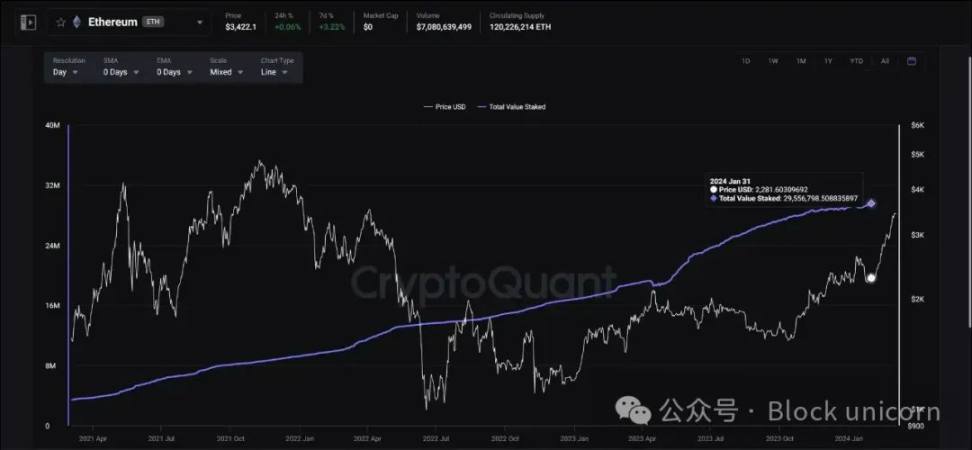
Ethereum staked on the network | Chart from CryptoQuant
How to Participate in Restaking
Participating in restaking requires a strategic approach and a deep understanding of underlying platforms and mechanisms. Potential participants should familiarize themselves with platforms like EigenLayer and EtherFi, which are at the forefront of the restaking movement.
General steps include acquiring liquidity staking tokens (LSTs) from platforms like Lido Finance and pledging these assets to the chosen restaking layer. By following this process, individuals and entities can contribute to the security and efficiency of multiple blockchain networks, while also leveraging new channels to generate returns and participate in the digital asset space.
BRC-20 Tokens: Making Bitcoin Smarter
BRC-20 tokens represent a significant innovation, bringing a new practical layer to the Bitcoin blockchain. Unlike the traditional basic unit of Bitcoin, satoshis, BRC-20 tokens introduce a novel concept by engraving a JSON file onto individual satoshis, creating a unique digital annotation for each, endowing them with distinct attributes and identities. These engravings can detail various properties, including the token's name, symbol, and total supply, transforming ordinary satoshis into versatile digital assets.
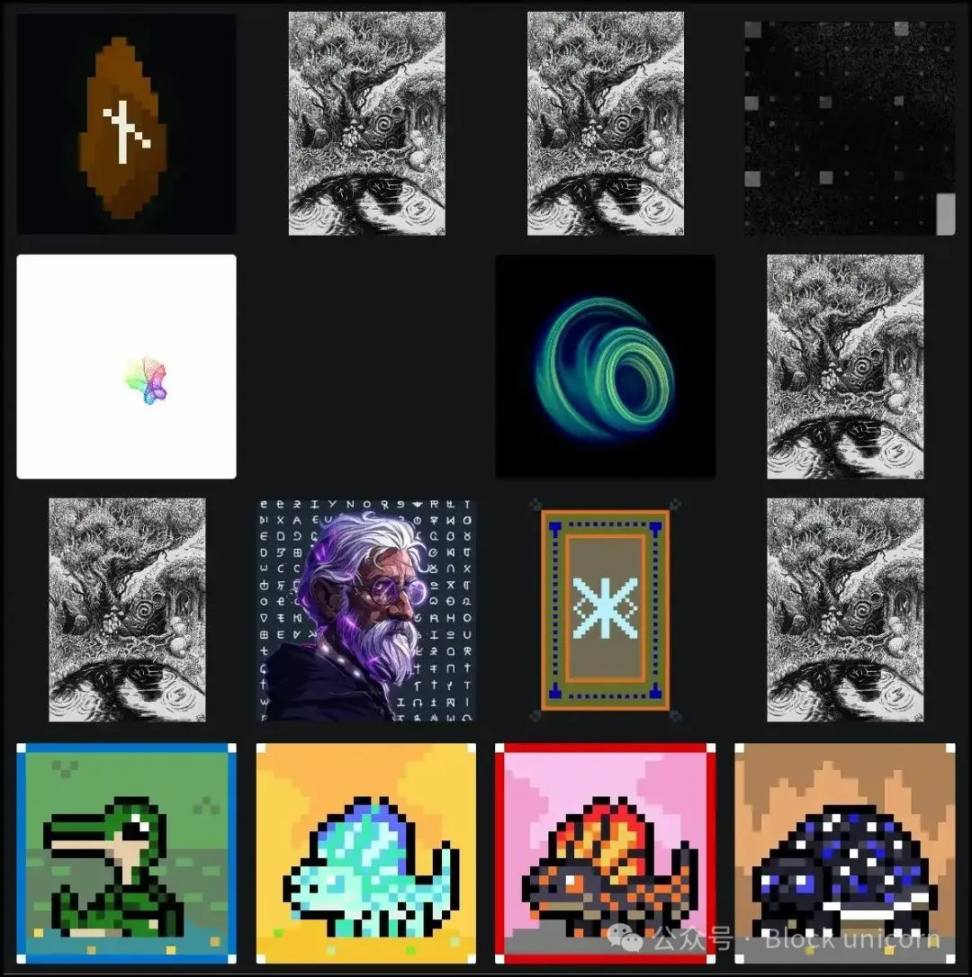
Ordinal Inscriptions as BRC-20 Tokens
A Comparative Overview of BRC-20 Tokens and ERC-20 Tokens
The creation of BRC-20 tokens (such as Ordinals) differs significantly from the established ERC-20 standard on the Ethereum blockchain. While ERC-20 tokens introduce new assets with properties independent of Ethereum using smart contracts, BRC-20 tokens utilize the inscription method. To create BRC-20 tokens, a specific quantity of Bitcoin must be deposited into the ordinal registry. These deposited bitcoins then serve as the pillars for BRC-20 tokens, with the token supply corresponding to the deposited quantity.
An interesting aspect of BRC-20 tokens is their operational framework, allowing them to run in parallel with the main Bitcoin blockchain. Therefore, if a transaction fails to meet predefined inscription conditions, it can be validated on the Bitcoin network while being rejected on the BRC-20 protocol.
The advantages of BRC-20 tokens include their simplicity and the robust security inherited from the Bitcoin blockchain. However, they also have some limitations. Due to the lack of smart contract functionality, their versatility is limited, and their interoperability with other blockchain systems is relatively restricted.
Future Prospects of BRC-20 Tokens
Looking ahead, BRC-20 tokens are poised to usher in a new era for the Bitcoin network. From enabling direct peer-to-peer transfers to facilitating the creation of Bitcoin-based DeFi applications and tokenizing real-world assets such as gold and real estate, BRC-20 tokens can significantly expand the use cases of Bitcoin, opening a new chapter in its legendary evolution.
ERC-7621: Basket Token Standard
ERC-7621 is a new token standard developed by Alvara Protocol. It aims to create and manage on-chain multi-token asset portfolios and investment baskets. It provides a framework for deploying token basket standards on the Ethereum blockchain. Individual BTS tokens can encapsulate arbitrary combinations of ERC-20 tokens, similar to mutual funds in traditional finance, thereby facilitating on-chain fund management.
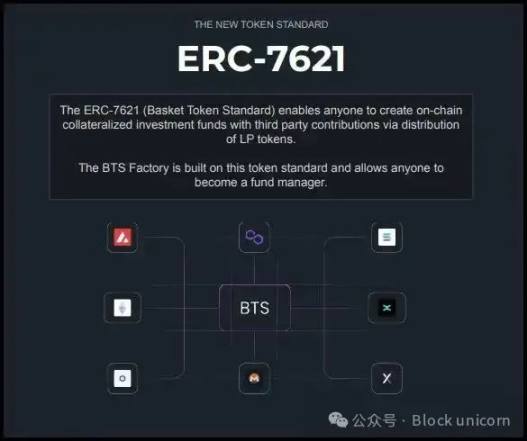
Alvara Protocol pioneering the Basket Token Standard | Image from Alvara Litepaper
Key Features and Innovations
- Basket Token Standard (BTS): A revolutionary approach that allows the creation of tokens containing various underlying ERC20 tokens.
- Transferability and Liquidity: Integrated with the ERC721 standard for ownership representation, making BTS transferable, enhancing liquidity and governance.
- Fungible BTS LP Tokens: These are the LP tokens of ERC-7621, representing ownership in the basket and usable in various DeFi applications, enhancing their utility beyond traditional fund holdings.
- Dynamic Deposits and Withdrawals: The protocol allows for the minting and burning of LP tokens with each deposit or withdrawal, maintaining consistency with the fund's dynamics.
- Management Fees and Rebalancing: ERC-7621 implements automatic management fee allocation and facilitates portfolio adjustments, simplifying fund management.
Alvara Protocol: Leveraging ERC-7621
Alvara Protocol leverages the ERC-7621 standard to provide a decentralized framework for creating and managing investment funds on the blockchain. With the support of the fund factory and market, Alvara enhances the visibility and performance tracking of BTS with its native ALVA and veALVA tokens, driving participation and governance in the ecosystem. The protocol democratizes fund management, ensuring an accessible and efficient elite environment.
Note: ERC-7621 is an experimental token standard and has not been formally proposed as an Ethereum Improvement Proposal. Therefore, it has not been reviewed by the Ethereum community, and readers planning to explore this new standard must approach it with caution.
ERC-404: Semi-Fungible Tokens
ERC-404 is another experimental token standard independently developed by Pandora Labs. While Ethereum supports the creation of fungible tokens through the ERC-20 standard and non-fungible tokens (NFTs) through the ERC-721 standard, Pandora Labs combines these concepts to create semi-fungible tokens, a solution very similar to fractional NFTs.
The idea of semi-fungible tokens has been circulating in Web3 almost since the emergence of NFTs. It specifies a scenario where NFTs need to be collectively owned on-chain. While a standard NFT token can only have one formal owner at a time, ERC-404 defines a standard that preserves the "non-fungibility" of NFTs while retaining the liquidity of ERC-20 tokens.
Operation of ERC-404:
ERC-404 tokens are both divisible and unique. When newly minted ERC-404 tokens represent ownership of virtual assets, the entire unit in your wallet is minted as an NFT within a single address. This address can then sell a portion of that token. Once the ERC-404 is divided, the protocol destroys the NFT. When an address collects enough portions of a specific ERC-404 token to reform a whole unit, the protocol remints the NFT within the associated address.
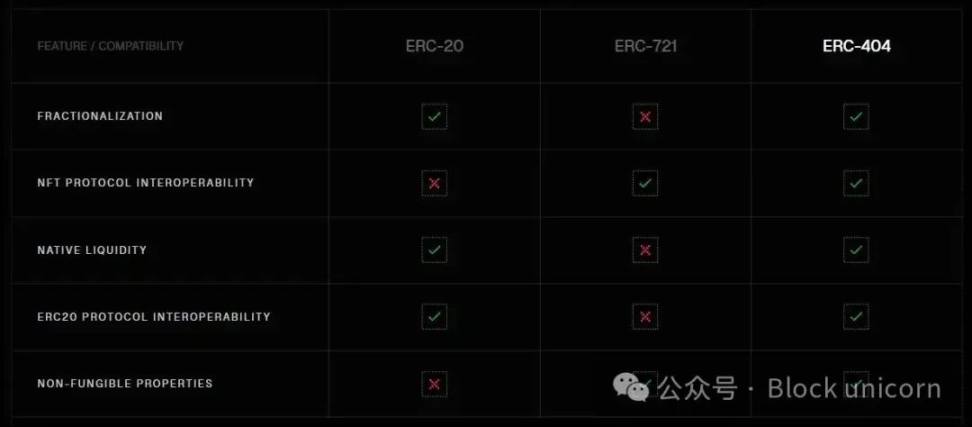
Comparison of ERC-404 Tokens with Other Token Standards | Image from Pandora website
Potential of ERC-404 Tokens
Pandora's innovation has many potential applications to expand the utility of NFTs. Firstly, people can use fractional NFTs as a source of liquidity to power liquidity pools, or own a diversified NFT basket instead of individually purchasing entire NFT units.
However, users must understand that ERC-404 is experimental and not a standard Ethereum Improvement Proposal. Pandora is independently developing it, and the Ethereum developer community has not reviewed it. Therefore, this innovation may have errors and vulnerabilities and may be prone to development bottlenecks.
Universal Data Availability Layer: Modular at the Forefront
Data availability is crucial as it ensures sufficient transaction data can be accessed during the consensus process. This accessibility is essential for validators or nodes to verify the validity of proposed block transactions. Data availability is the foundation for maintaining chain liveness, where the network continues to agree on transaction sequences and ensures consistently identifying and rejecting invalid transactions.
However, creating a dedicated data availability (DA) layer is resource-intensive. It requires powerful hardware capabilities and staking requirements to ensure robustness and security. To mitigate these challenges, the blockchain industry is witnessing the rise of universal DA layers. These layers provide a shared infrastructure that new or emerging blockchain networks can simply "subscribe" to, alleviating the need for each chain to build its own expensive data availability solutions.
Prominent Data Availability Solutions
Celestia: Celestia is a pioneering solution in the field, providing a modular blockchain network that decouples data availability from consensus, enabling scalable and flexible blockchain design.
EigenDA: EigenDA provides a unique data availability method by using liquidity staked tokens, thereby improving the efficiency of blockchain networks.
Polygon Avail: As part of the Polygon suite, Avail aims to act as a powerful and decentralized data availability layer, supporting various blockchain architectures and enhancing their performance and security.
Advantages of Dedicated Data Availability (DA) Layers
The emergence of dedicated DA layers brings several advantages to the blockchain ecosystem:
- Reduced costs for new chains: By leveraging existing DA layers, new blockchain projects can significantly reduce their startup and operational costs.
- Efficient resource utilization: Dedicated DA layers optimize the resource usage of the entire ecosystem, preventing redundancy and promoting eco-friendly blockchain operations.
- Enhanced decentralization: Through accessible DA services, smaller chains can achieve levels of security and decentralization that would otherwise be unattainable.
- Foundation for application-specific chains: These layers facilitate the development of application-specific chains or "app chains," enabling customized blockchain solutions to meet unique needs without compromising data integrity or availability.
Essentially, dedicated data availability layers are changing the landscape of blockchain, providing support for the growth and diversification of the Web3 ecosystem. They demonstrate the ongoing evolution and maturation of blockchain technology, paving the way for more resilient, scalable, and application-centric networks.
DePIN: Decentralized Physical Infrastructure Network
The Decentralized Physical Infrastructure Network (DePIN) represents a groundbreaking movement in the crypto space, integrating blockchain technology with real-world physical infrastructure. The DePIN project leverages blockchain decentralization and tokenization to innovate in areas such as data storage, energy, and connectivity, transforming the provision and management of physical services. Notable examples such as The Graph Protocol, Theta Network, and Arweave illustrate the potential of DePIN, showcasing how blockchain extends its utility beyond the digital realm to impact tangible real-world infrastructure.
- The Graph Protocol indexes and queries network data using blockchain, effectively creating decentralized services for information retrieval.
- Theta Network decentralizes video streaming by allocating bandwidth to users, improving the quality and coverage of streaming services.
- Arweave offers a novel data storage solution, allowing information to be permanently stored on a decentralized network.
These initiatives demonstrate how DePIN is redefining infrastructure, using crowdsourced contributions to enhance service efficiency and accessibility.
Advantages of DePIN Compared to Traditional Systems
Compared to traditional infrastructure models, DePIN offers several advantages:
- Decentralization: By distributing control and ownership, DePIN ensures that no single entity can monopolize services, fostering a more democratic infrastructure ecosystem.
- Transparency: The inherent transparency of blockchain allows all network participants to view and verify transactions and operational processes.
- Incentivization: DePIN uses cryptocurrency rewards to incentivize participation, ensuring that infrastructure is maintained and enhanced by a self-organizing community.
- Accessibility: DePIN lowers entry barriers, enabling a wider range of participants to contribute to and benefit from physical infrastructure services.
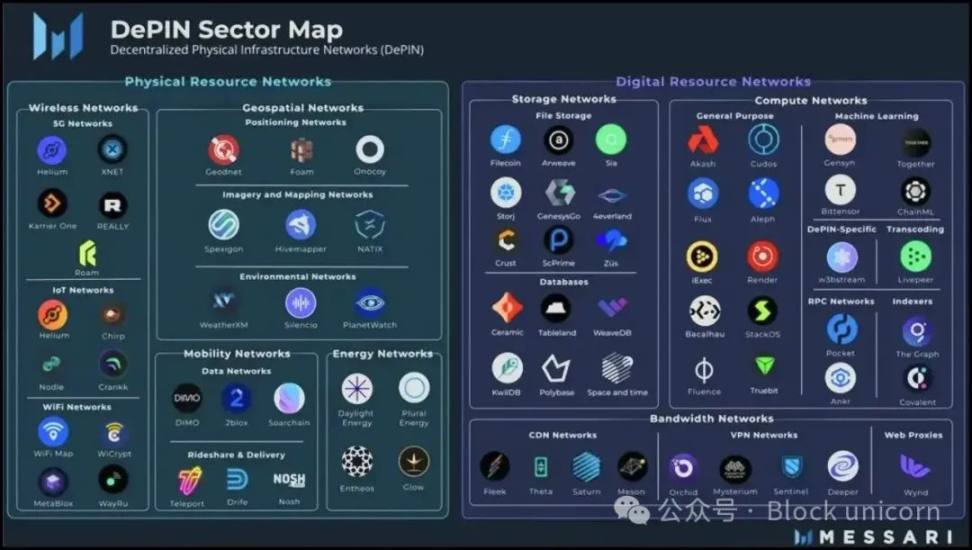
DePIN's Zoning Map | Image from X
Challenges Facing DePIN
Despite its potential, DePIN faces some challenges:
- Integration with physical infrastructure: Connecting digital blockchain systems with physical infrastructure requires innovative solutions and robust middleware to ensure seamless operation.
- Scalability: Ensuring effective scalability as these networks grow while maintaining service quality and network security is crucial.
- Regulatory compliance: Understanding the regulatory environment, especially in areas such as energy and transportation, is essential for the adoption and success of DePIN.
In conclusion, DePIN is poised to transform physical infrastructure, making it more decentralized, transparent, and user-centric. By addressing relevant challenges through innovative and collaborative approaches, DePIN has the potential to have a significant impact on global scientific research and the way it is shared.
Decentralized Science: Revolutionizing Research and Innovation
Decentralized Science (DeSci) is an innovative movement using blockchain technology to transform the landscape of scientific research, collaboration, and publishing. DeSci addresses several long-standing issues in traditional science, such as inaccessible data, lack of transparency in research funding and publishing processes, and the monopolization of knowledge by a few gatekeeping institutions. By leveraging the inherent transparency, immutability, and decentralization of blockchain, DeSci promotes open collaboration, democratizes access to scientific data, and simplifies funding mechanisms.
Role of DeSci in Data Sharing, Research Publishing, and Funding
DeSci fundamentally changes data sharing by implementing transparent, immutable scientific data records, facilitating peer review, and encouraging collaborative cross-border research. DeSci challenges traditional research publishing models by providing a decentralized platform where research findings can be published without excessive gatekeeping, ensuring faster dissemination and recognition of scientific discoveries.
Additionally, DeSci introduces innovative funding models, such as decentralized autonomous organizations (DAOs), allowing community members to directly fund research projects they believe in. This model accelerates the funding process and democratizes decision-making, aligning research incentives with the interests of the community rather than catering to the interests of a few.
Notable Projects in DeSci
- VitaDAO: VitaDAO focuses on funding longevity research. By leveraging blockchain technology, community members have a voice in the research projects they fund, fostering direct connections between researchers and the public.
- Athena DAO: Athena DAO focuses on biomedical research, using blockchain to facilitate funding and collaboration in the medical research field, ensuring widespread and transparent sharing of research findings.
- Vallet DAO: Vallet DAO is another significant player in the DeSci field, aiming to decentralize the funding and publishing processes of scientific research, making them more accessible and efficient.
In conclusion, DeSci is redefining the paradigm of scientific research and publishing, breaking down barriers to information access, ensuring greater transparency, and promoting a more inclusive, collaborative approach to scientific inquiry. Through projects like VitaDAO, Athena DAO, and Vallet DAO, DeSci is not just a concept but a continually evolving reality with the potential to have a significant impact on the advancement and sharing of global scientific research.
Tokenization of Real-World Assets (RWA)
The tokenization of Real-World Assets (RWA) is an emerging niche market in the 2024 cryptocurrency space, gaining momentum for its innovative approach that integrates tangible and digital realms. RWAs are blockchain tokens representing ownership or equity in physical and traditional financial assets. The industry is rapidly expanding, with various projects tokenizing a range of assets, including cash, commodities, real estate, and more, bringing these assets onto the blockchain to enhance liquidity, accessibility, and efficiency.
The tokenization of assets works by converting the rights to assets into digital tokens on the blockchain. The process involves first verifying and assessing the assets, then creating digital representations (tokens) that reflect ownership or claims to the asset's value. These tokens can then be bought, sold, or traded on digital platforms, allowing for fractional ownership and broader investment opportunities that were previously difficult to access due to high entry barriers or lack of liquidity.
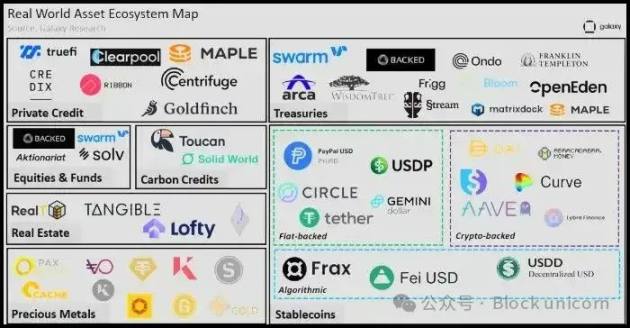
RWA Industry | Image from Galaxy Digital
Benefits of RWA
- Accessibility and Inclusivity: Tokenization democratizes access to investment opportunities, allowing more people to invest in high-value assets through fractional ownership.
- Liquidity: Tokenizing real-world assets can enhance their liquidity, making it easier to trade these assets without traditional intermediaries.
- Transparency and Efficiency: Blockchain technology ensures transparency, providing clear visibility into asset ownership and transaction history, reducing fraud and speeding up transactions.
Risks of RWA
- Regulatory Uncertainty: Tokenizing real-world assets navigates complex regulatory environments where clarity and compliance are still evolving.
- Market Risk: The value of tokens may fluctuate, influenced by the performance of underlying assets and broader dynamics in the crypto market.
- Operational Risk: The process involves various stakeholders, including corporate entities, custodians, and token issuers, whose operational integrity is crucial for the tokenization and ongoing management of assets.
Projects in the RWA Space
- ONDO: ONDO focuses on democratizing financial assets, providing a platform for fractional ownership and investment in real-world assets through blockchain technology.
- Polymesh: Polymesh is a blockchain designed for regulated assets, facilitating compliance and providing a framework for issuing and managing securities on the blockchain.
- MANTRA: MANTRA operates in the DeFi space, expanding its products to tokenize real-world assets, aiming to bridge the gap between traditional finance and DeFi.
In conclusion, the tokenization of real-world assets represents a significant leap in the convergence of the physical and digital worlds, offering numerous benefits while also presenting unique challenges.
Summary
As we examine the dynamic landscape of the 2024 cryptocurrency industry, it is clear that this industry is not just rebounding; it is evolving, diversifying, and maturing. This resurgence is built on a wave of innovation that expands the boundaries of possibilities in the blockchain and crypto space. From the liquidity enhancement mechanisms of staked tokens to the groundbreaking integration of blockchain with the physical world through decentralized physical infrastructure networks, each narrative we explore marks a step towards a more interconnected, efficient, and accessible digital future.
The emergence of tokenized real-world assets signifies a new era of convergence between traditional asset markets and blockchain technology, providing unprecedented investment and asset management opportunities. At the same time, Decentralized Science (DeSci) is poised to fundamentally change the foundation of scientific research and publishing, nurturing a more collaborative, transparent, and inclusive global research community.
However, as we marvel at these advancements, it is crucial to maintain a balanced perspective on this new frontier. Many of these innovations are still in their infancy, meaning they are undergoing challenges in real-world applications and market acceptance. Additionally, the regulatory environment is evolving, bringing potential challenges and shaping the development trajectory of these emerging industries.
The cryptocurrency landscape of 2024 demonstrates the resilience and relentless innovation of the blockchain community. As we embark on this hopeful yet unpredictable journey, staying informed, adaptable, and insightful will be key to seizing the opportunities of this new digital era and addressing its challenges. The future of cryptocurrency is unfolding before us, full of potential and possibilities waiting to be grasped.
免责声明:本文章仅代表作者个人观点,不代表本平台的立场和观点。本文章仅供信息分享,不构成对任何人的任何投资建议。用户与作者之间的任何争议,与本平台无关。如网页中刊载的文章或图片涉及侵权,请提供相关的权利证明和身份证明发送邮件到support@aicoin.com,本平台相关工作人员将会进行核查。




